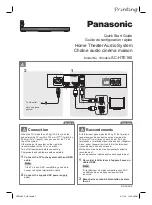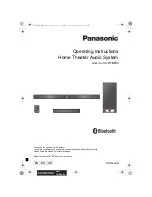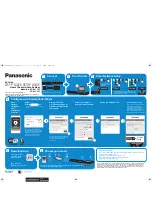
5
4
CONNECTIONS
1. Connect both speakers using the speaker cable provided and the appropriate terminals (1)/(6). Insert the centre
wires into the sockets by pressing the terminal on the speaker jack.
2. Now connect your signal source using the signal input connector (2) (cinch). You can connect an external subwoofer
using the subwoofer out (3) if required.
3. Connect the power cable supplied to the power cable connection (4) and plug it into your power socket.
OPERATION
1. ENSURE THE VOLUME CONTROL IS AT THE MINIMUM POSITION
Turn the volume control dial (12) to Minimum position (turn controller left) before you switch the device on.
2. TURN ON THE POWER
Once everything is connected, turn the device on using the On/Off switch (5).
3. ADJUST THE VOLUME
Adjust the volume using the volume control dial (12).
4. SELECT SIGNAL INPUT
You have the choice of 2 possible signal input sources:
Cinch (2)
Bluetooth (7)
To connect a playback device via cinch, connect the cinch cable of your playback unit using the cinch socket (2)
on the DSM-3 BT monitor 1.
NOTE
Please ensure that the signal strength of your chosen playback device is sufficient. Many playback devices,
for example various record players, may require an additional preamplifier for direct connection to achieve
sufficient signal strength.
When the DSM-3 BT is turned on, the Bluetooth pairing LED (8) glows white. To use a Bluetooth playback device,
first enable Bluetooth on the chosen playback device and then press the Bluetooth pairing button (7) on your DSM-
3 BT monitor 1. When the DSM-3 BT appears on your Bluetooth device, press „Connect“. While in pairing mode, the
Bluetooth pairing LED (8) will flash blue and white alternately. Once the connection is established, the Bluetooth
pairing LED (8) will glow blue. To connect to a different Bluetooth device, press the Bluetooth pairing button (7)
again to cancel the active Bluetooth connection and return to pairing mode. Repeat the process described above.
TONE CONTROL
You can raise or lower the bass and treble using the bass controller (10) and treble controller (11). The ideal setting
will depend on the particular features of the room. A room with excellent sound insulation will need the higher
frequencies increasing. Conversely, higher frequencies need lowering in rooms with reverberation.
TECHNICAL DATA
-
Type: 2-channel bass reflex, active monitor speaker system
-
Tweeter: 0.5“ tweeter (1.30 cm)
-
Woofer: 3.5“ bass (8.89 cm)
-
Housing dimensions: 140 x 222 x 152.5 mm
-
Weight: 2.8kg (pair)
-
Frequency range: 80-20,000 Hz
-
Amplifier power: class A/B amplifier: 2 x 20 W RMS
- Magnetic shielding
-
Inputs: 1 x line (RCA), 1 x wireless Bluetooth ®
-
Outputs: 1 x headphone monitor (3.5 mm jack), 1 x subwoofer (3.5 mm jack)
SUPPORT
If you require further help or have technical questions,
please see our Reloop FAQs or contact our support team:
https://www.reloop.com/faqs.html
https://www.reloop.com/support-ticket-request
In compliance with international safety certification requirements (e.g. CE, UKCA, FCC), all necessary documents are held by our official Importer. You
can find our current importer for your territory listed as Distributor in the ‘Where To Buy section’ of our website: https://www.reloop.com/dealer-area
INSTALLATION
1. Please stick 4 of the rubber pads provided to the base of each of your DSM-3 BT monitors to protect them from
vibrations and slipping.
2. For optimum audibility of the high frequencies we recommend installing the tweeter of the studio monitors at face
level; if necessary use an appropriate speaker stand. Be sure to use an even, stable underground; if necessary, use
sound cushioning material.
3. These speakers are near-field monitors which can be set up at a short distance to the listener.
4. To avoid reflection from walls that are too close (e.g. room corners), turn the speakers slightly towards you. To
optimise your ambience acoustics, you may use sound absorbing plates.
CLOSE-RANGE INSTALLATION
In studios, monitor speakers are usually positioned on the studio console (at head height). The monitors and the
position of the listener should also form an isosceles triangle; in other words place them at an angle of 60° to the
listening position.
MID-RANGE INSTALLATION
The mid-range installation arrangement should be similar to the close-range installation set-up. This variant is
usually selected for larger monitors where they are too large or too heavy to be placed on the studio console. This
set-up provides a larger „listening position“ and creates better acoustic conditions in the room. With mid-range
installation, the bass for the monitors should be positioned above the studio console.
ENGLISH
ENGLISH





























